Dell’s Inspiron 13 7391-Series Ultra-Light Laptops: 10th Gen Core & a dGPU at Under 1 Kg
by Anton Shilov on August 21, 2019 2:00 PM EST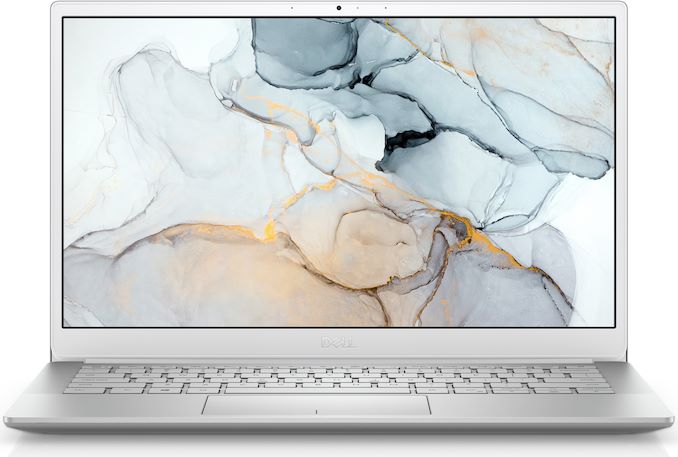
Among the many laptop families receiving updates today in line with the launch of Intel's 10th gen Core CPUs, Dell has introduced its all-new Inspiron 13 7391-series laptop. The latest Inspiron 13 brings together Intel’s Comet Lake processors, NVIDIA’s discrete GPUs, a spill-resistant keyboard, and an ultra-low weight. In a bid to keep the laptop weight at 955 grams, Dell had to omit usage of a touch-enabled or a 4K display panel, but those who need the lightest notebook possible should find the trade-off worth it.
At the heart of the Inspiron 7391-series is Intel’s 10th gen Core i5/i7 processors, accompanied by NVIDIA’s GeForce MX 250 graphics processor with 2 GB vRAM, up to 8 GB of soldered-down system DRAM, and an M.2 PCIe SSD featuring capacities ranging from 128 GB to 1 TB. The laptop has multiple sensors to determine whether it is used on the desk, in hands, or on lap tops, in a bid to apply appropriate thermal profile to the situation.
The Inspiron 7391 laptop is equipped with a 13.3-inch Full-HD non-touch display panel with thee-sided narrow bezels as well as Dell’s TrueLife LED backlighting. Dell does not disclose the type of LCD it uses, yet it says that it features wide viewing angles. One interesting feature of the monitor is its lid-open sensor that turns on the laptop even when it is completely shut down.
When it comes to connectivity, Dell's latest laptop offers 802.11ac Wi-Fi, one USB 3.1 Gen 1 Type-C port with DisplayPort, one USB 3.1 Gen 1 Type-A, one HDMI 1.4 port, a microSD card reader, a 3.5-mm connector for headsets, and a power plug. Multimedia capabilities of the notebook include a Windows Hello-capable webcam, stereo speaker, a microphone array, a Windows Hello-supporting fingerprint reader, and other essentials.
The Dell Inspiron 7391-series comes in a chassis made of a painted magnesium alloy that is only 14.9 mm thick. Depending on configuration, the Dell Inspiron 7391 will come with a 45 Wh or 52 Wh battery, so its weight will start at 955 grams, but will get higher depending on the spec.
Unfortunately, however, European and North American customers won't be able to buy the Inspiron 7391, at least initially. As it turns out, Dell is initially launching the machine in Brazil, China, and Japan. Considering how popular ultralight laptops are in Japan and China, it is not surprising that Dell wants to sell the Inspiron 7391 in these countries. That said, since the market of sub-kilogram notebooks is not crowded in Europe and the US, I would not be too surprised if these machines eventually made it elsewhere after they become available in China (August 23), Japan (September 3), and Brazil (December 11).
Related Reading:
- Dell Launches AMD Ryzen-Based Inspiron 13 7000 2-in-1 Convertible, Starts at $700
- Dell Updates Inspiron 15 7000 Gaming Notebook: GeForce GTX 1060 and Thunderbolt 3
- Dell’s XPS 13 2-in-1 7390 Available: Intel’s 10th Gen Core CPUs Inside
- VAIO’s 2-Pound 12.5-Inch Laptop Weds Miniature Dimensions & Vast Connectivity
- Fujitsu Announces 13.3" Lifebook U937/P and UH75/B1: 7th Gen Core i5, 8hr Battery, Under 1.77 lbs
- Dynabook Shows Off New G-Series Laptops: Under 2 Pound Ultrabook With 19 Hour Battery Life
Source: Dell


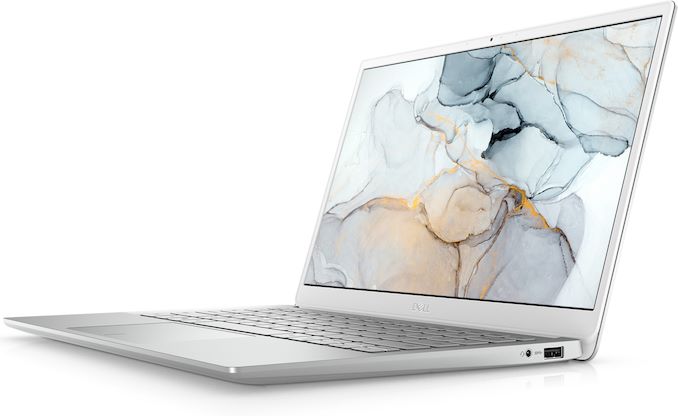
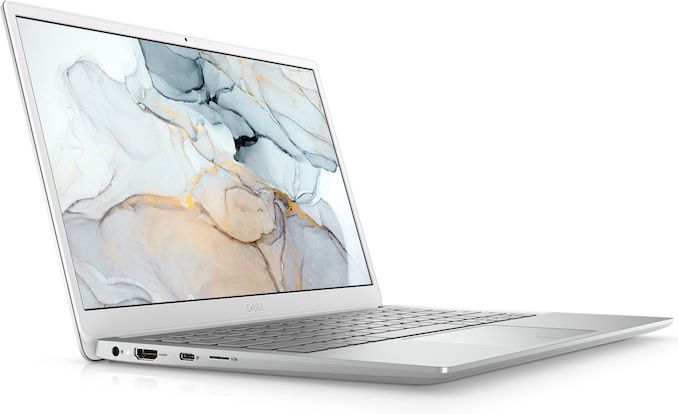
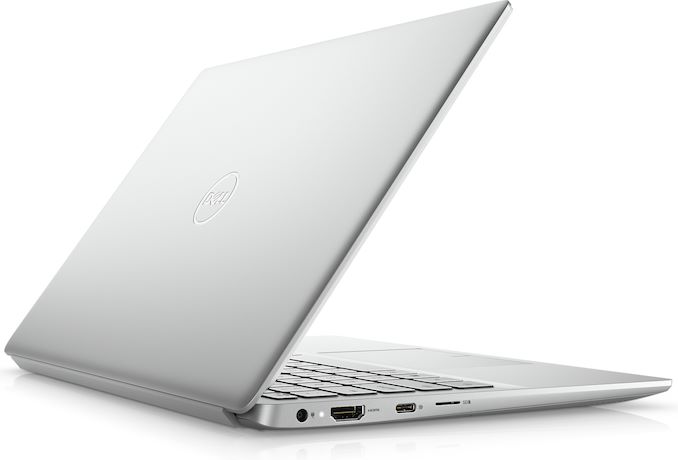
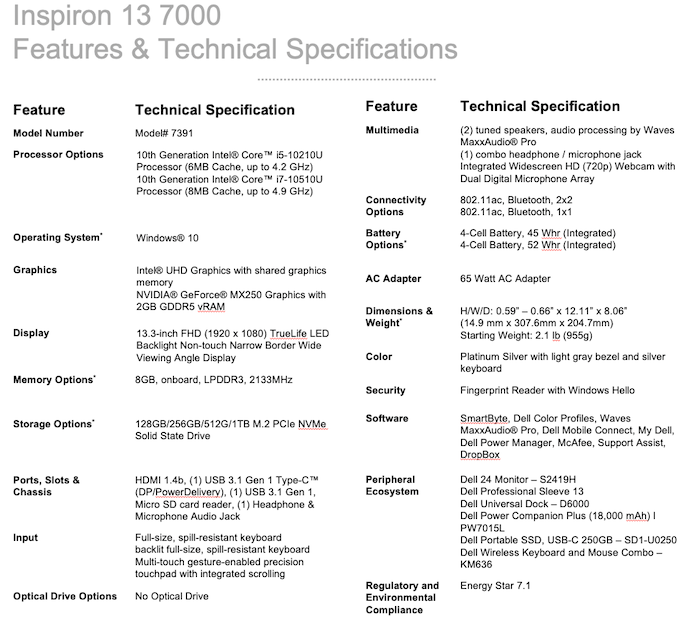








18 Comments
View All Comments
NICOXIS - Wednesday, August 21, 2019 - link
Why would they choose a 14nm CPU and a dedicated GPU when they could use their ice lake G7 CPUs with comparable performance and way better battery life and thermals?? Is 10nm still not shipping in volume?patel21 - Wednesday, August 21, 2019 - link
For non-tech users, a laptop with DGPU seems to be a better deal, even when iGPU is as much powerful.Intel also might have something to do with this. As they are promoting ice lake for their Project Athena premium laptops.
IntelUser2000 - Wednesday, August 21, 2019 - link
The MX250 is still faster than Icelake. Notebookcheck shows the MX150 showing 50% advantage in games.Also, manufacturers have used dGPUs when the iGPUs were on par. Probably a brand thing. If you can claim it has a dGPU, it becomes a selling point.
@patel21
Comet Lake laptops can also be certified for Project Athena. Of course it might be harder to do so, but it doesn't need to use Icelake.
0ldman79 - Monday, October 7, 2019 - link
Even if performance is decent, you're talking about a laptop with 8GB of RAM.Sharing that with the iGPU is problematic and even a discrete GPU that only matches the iGPU in power has it's own VRAM.
brakdoo - Wednesday, August 21, 2019 - link
10 nm Ice Lake obviously still has problems with yield and volume. They are not even used in configurations without dGPU.All new high volume laptops will be released with Comet Lake (like XPS 13, unlike low volume XPS 13 2-in-1).
+Don't expect too many G7 configs because they are expensive (adding a GF mx might be cheaper and much faster) and disabling GPU EUs is the easiest way to raise yields.
PeachNCream - Wednesday, August 21, 2019 - link
Non-upgradable 8GB RAM for a new laptop with a dGPU, even a low end one like the MX250, seems like a noteworthy detriment to longevity.obama gaming - Wednesday, August 21, 2019 - link
Why only LPDDR3? I thought 10th gen supported LPDDR4Xjeremyshaw - Wednesday, August 21, 2019 - link
AFAIK, LPDDR4x signaling has much stricter requirements than LPDDR3, so cheaper designs (8GB max, soldered...) will probably just stick with what's easier.abufrejoval - Tuesday, August 27, 2019 - link
With a dGPU, RAM bandwidth is no longer a real-world issue: iGPUs eat bandwidth.yuriylsh - Wednesday, August 21, 2019 - link
I thought that the selling points of Commet Lake are LPDDR4X and 802.11ax(wifi 6). So I am a bit confused why would Dell update the processor but do not utilize the advantages it could bring in with it?